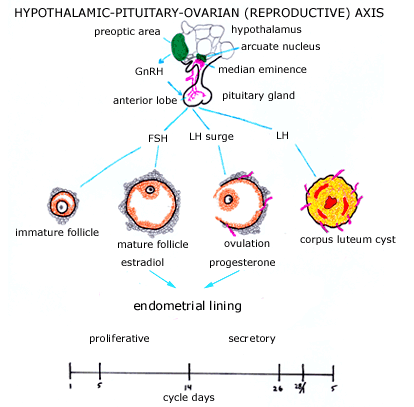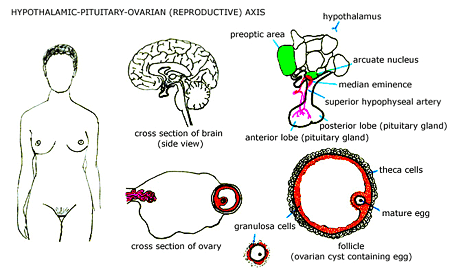| visit: www.infertilitytutorials.com |
|
The sequence of events that leads to ovulation during the reproductive years most directly involves the hypothalamus, pituitary gland and ovary. Gonadotropin Releasing Hormone (GnRH) is a hormone produced by the hypothalamus (within the brain) that is able to stimulate the secretion of “Follicle Stimulating Hormone” (FSH) and “Luteinizing Hormone” (LH) from the (anterior lobe of the) pituitary gland. The two regions of the human hypothalamus that contain the majority of GnRH neurons are (1) the preoptic area of the anterior hypothalamus and (2) the arcuate nucleus of the medial basal hypothalamus. GnRH produced by these neurons is transported to (and secreted into) blood vessels within an area called the “median eminence” and these vessels then carry GnRH to the anterior lobe of the pituitary gland. Pulsatile GnRH secretion must occur within a very narrow critical range of frequency and amplitude in order for normal FSH and LH secretion from the pituitary gland. The anterior lobe of the pituitary gland is able to release FSH and LH into the general circulation. FSH and LH are pituitary hormones that are transported (via blood vessels) to the ovary where they bind to specific receptors and function in the process of egg (and ovarian follicle) maturation. The entire ovarian “cyst” containing the egg is referred to as a “follicle” prior to ovulation and a “corpus luteum” cyst after ovulation. During the process of egg maturation (prior to ovulation within a menstrual cycle) it appears that LH acts predominantly on the theca cells that are immediately outside the developing follicle(s), to enhance production of androgenic hormones (androstenedione and testosterone). These androgenic hormones subsequently cross over the basement membrane of the follicle where granulosa cells convert the hormones into estrogen under (predominantly) the influence of FSH. FSH concurrently appears to enhance the development of mature eggs within these ovarian follicles.
A sudden sharp increase in LH concentration (the “LH surge”) occurs just prior to ovulation (the onset of the LH surge occurs about 36 hours prior to ovulation). In fact the LH surge triggers the final maturation steps that must occur within the egg and follicle prior to ovulation. In spontaneous (natural) ovulation cycles it is thought that the high estrogen concentration produced by the developing ovarian follicle(s) is the primary signal to the pituitary gland that the eggs are “ready” for the “LH surge” and ovulation. Following ovulation, the granulosa cells lining the ovarian follicle convert from estrogen producing cells to progesterone producing cells. The corpus luteum cyst typically assumes a yellow coloration (the yellow pigment is termed “luteum”) to give the cyst its name. The enhanced blood supply to the corpus luteum cyst allows for the delivery of large amounts of circulating steroid precursor molecules (such as cholesterol) for the abundant production of progesterone. There are often blood clots and remnants of the ovulation process within the corpus luteum cyst, giving these ovarian cysts a wide variety of appearances (when viewed by ultrasonography or directly). The estrogen (estradiol is the most bioactive form of estrogen) produced by the developing follicle(s) prior to ovulation stimulates the uterine lining cells (endometrial lining) within the uterine cavity to proliferate (grow or increase in number) such that this lining thickens. The progesterone produced after ovulation then modifies this thickened endometrial lining architecturally to allow for embryo implantation and the development of a normal pregnancy. If a pregnancy does not result within about 14 days (two weeks) of ovulation, the estrogen and progesterone production by the ovary drop precipitously and the lining that was grown for that menstrual cycle is shed as the menstrual flow. Normally, this process repeats itself on a monthly schedule throughout the reproductive years. | |||||||||||||||


